Mastering CSS Selectors: A Comprehensive Guide to Targeting HTML Elements
CSS selectors are the heart of the Cascading Style Sheets language. Selectors enable web developers to target specific HTML elements on a web page and apply styling to them. By using selectors, developers can create a visual style and layout for their web page, which is separate from the HTML content.
There are several types of selectors that can be used in CSS. The simplest selector is the type selector, which targets all instances of a particular HTML element on a page.
Universal selectors target all elements on a page, while attribute selectors target elements with a specific attribute or attribute value.
In addition to these basic selectors, CSS also provides more advanced selectors, such as pseudo-classes and pseudo-elements. Pseudo-classes target elements based on their state, such as when they are hovered over or clicked. Pseudo-elements, on the other hand, allow developers to style specific parts of an element, such as the first letter or line of a paragraph.
CSS also provides combinators, which are used to target elements based on their relationship to other elements on the page. Descendant selectors, child selectors, and sibling selectors are all examples of combinators that can be used to create complex selectors.
CSS selectors are used to "find" (or select) HTML elements based on their.Mainly used Selectors are following :
- Element( tagname)
- ID (#)
- Class (.)
Element or Tag Selector
Element or tag selectors are the simplest type of CSS selectors. They target all instances of a particular HTML element on a web page and apply styling to them. For example, the "h1" selector targets all <h1> headings on a page and can be used to change their color, or any other style property.
To use an element selector, simply specify the element name as the selector in the CSS rule. For example,
h1{ color:red; }
Output

This would apply the color of red to all <h1> headings elements on the page.
One of the benefits of using element selectors is that they are easy to understand and use. They also have a low specificity value, meaning that they are less likely to override other styles applied to the same element. However, they are not very precise and can affect all instances of an element on a page, which can be problematic if you want to style a specific instance of an element differently.
Overall, element selectors are useful for making broad changes to the styling of a web page, but should be used with caution to avoid unintended consequences. It's important to balance the use of element selectors with more specific selectors, such as class or ID selectors, to create a well-organized and efficient stylesheet.
Id Selector
ID selectors in CSS are used to target a specific HTML element on a web page based on its unique ID attribute. An ID attribute is a unique identifier assigned to an HTML element, and it is used to distinguish that element from other elements on the same page.
To select an element using an ID selector, you need to specify the ID name preceded by a hash (#) symbol in the CSS rule.
ID selectors have a higher specificity value than element selectors, meaning that they take precedence over styles applied using element selectors. This makes ID selectors useful for targeting specific elements and overriding global styles.
- The id selector uses the id attribute of an HTML element to select a specific element.
- An id should be unique within a page, so the id selector is used if you want to select a single, unique element.
- To select an element with a specific id, write a # character, followed by the id of the element.
Example
#para{ color:red; }
Output

It's important to note that ID attributes should be unique on a web page, meaning that they should only be used once per page. Using the same ID attribute for multiple elements can lead to conflicts and unpredictable behavior.
In general, it's best to use ID selectors sparingly and only for elements that require unique styling or functionality. Overusing ID selectors can lead to overly specific and complex stylesheets, which can be difficult to manage and maintain over time.
Class Selector
Class selectors in CSS are used to target specific HTML elements based on their class attribute. A class attribute is a way to group similar HTML elements together and apply styles to them collectively.
To select an element using a class selector, you need to specify the class name preceded by a dot (.) symbol in the CSS rule.
- The class selector selects elements with a specific class attribute.
- To select elements with a specific class, write a period(.) character, followed by the name of the class.
Example
.para{ color:green; }
Output

Class selectors have a lower specificity value than ID selectors but higher than element selectors, meaning that they take precedence over element selectors but are overridden by ID selectors. This makes class selectors useful for targeting specific groups of elements and creating reusable styles that can be applied to multiple elements.
One of the benefits of using class selectors is that they can be applied to multiple elements on a page, allowing you to create consistent styles for similar elements. You can also combine class selectors with other selectors, such as element selectors or ID selectors, to create more specific styles for individual elements.
Overall, class selectors are a powerful tool for creating flexible and reusable stylesheets in CSS. When used correctly, they can help you create consistent and maintainable styles for your web pages.
Universal Selector
The Universal Selector in CSS is a selector that matches all elements on a web page. It is denoted by an asterisk (*) and can be used to apply styles to all HTML elements.
Rather than selecting elements of a specific type, the universal selector quite simply matches the name of any element type.
Example
*{ margin:0px; padding:0px; }
Output
Before using Universal Selector
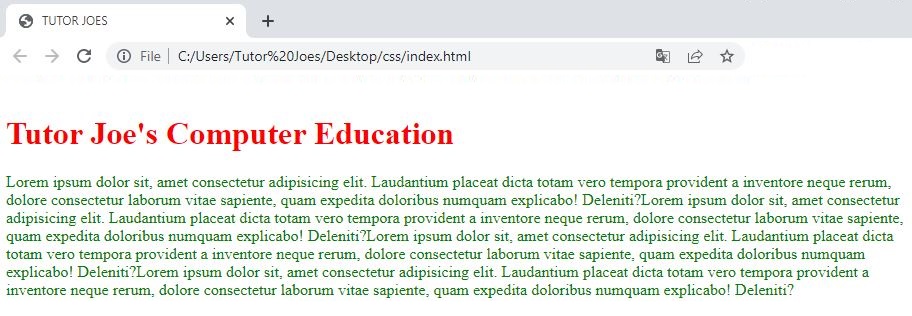
After using Universal Selector
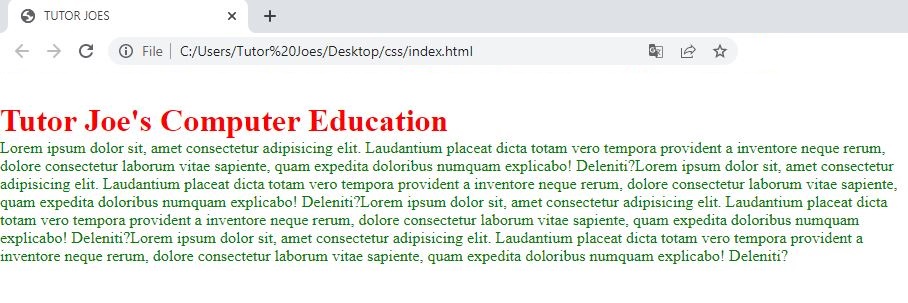
The Universal Selector can also be combined with other selectors to create more specific styles
While the Universal Selector can be a useful tool for applying styles to multiple elements at once, it can also have performance implications if used excessively. Because it matches all elements on a page, it can slow down the rendering of large web pages and cause performance issues on slower devices.
In general, it's best to use the Universal Selector sparingly and only when necessary. Whenever possible, it's better to use more specific selectors to target individual elements or groups of elements. This can help improve the performance and maintainability of your CSS code.
Descendant Selector
The Descendant Selector in CSS is a selector that matches an element that is a descendant of another element. It is denoted by a space between two or more selectors, where the first selector represents the ancestor element and the second selector represents the descendant element.
Suppose you want to apply a style rule to a particular element only when it lies inside a particular element.
Example
ul li{ font-family:roboto; color:#8000ff; }
Output
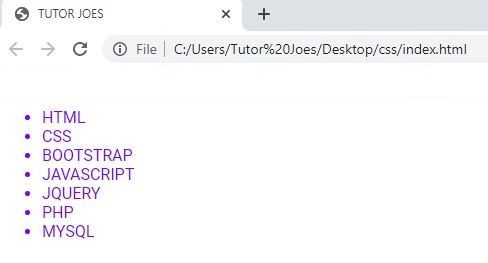
The Descendant Selector allows you to target specific elements that are nested inside other elements on a web page. You can use it to create more specific styles for individual elements and avoid applying styles to other elements that may have the same class or ID attributes.
Overall, the Descendant Selector is a powerful tool for creating more specific and targeted styles in CSS. When used correctly, it can help you create more maintainable and scalable stylesheets for your web pages.
Child Selector
The Child Selector in CSS is a selector that matches an element that is a direct child of another element. It is denoted by a greater than symbol (>) between two selectors, where the first selector represents the parent element and the second selector represents the child element.
There is one more type of selector, which is very similar to descendants but have different functionality.
Example
div > p { color:red; line-height:30px; }
Output
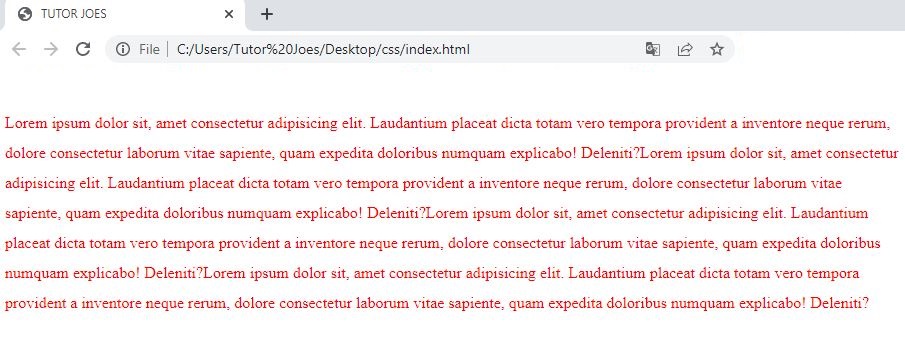
The Child Selector allows you to create more specific styles for elements that are direct children of other elements, rather than all descendants of an element. This can be useful in cases where you want to target only the top-level elements in a nested HTML structure.
It's important to note that the Child Selector only selects elements that are one level below the parent element. If there are multiple levels of nesting, the Child Selector will not match the elements that are further down the hierarchy.
Overall, the Child Selector is a useful tool for creating more specific and targeted styles in CSS. When used in combination with other selectors, such as class or ID selectors, it can help you create more maintainable and scalable stylesheets for your web pages.
Attribute Selector
In CSS, an attribute selector is a way to target elements based on the presence or value of their attributes. It allows you to select elements that have a specific attribute or apply styles to elements based on the attribute value. Attribute selectors are denoted by square brackets [ ] and can be used with various comparison operators.
Here are some examples of how attribute selectors work:
Select elements with a specific attribute:
[attribute] { /* Styles applied to elements with the specified attribute */ }
This selects all elements that have the specified attribute, regardless of its value. For example, [required] selects all elements that have the required attribute.
Select elements with a specific attribute and value:
[attribute=value] { /* Styles applied to elements with the specified attribute and value */ }
This selects elements that have the specified attribute and exactly match the attribute value. For example, [type=text] selects all elements with type="text".
Select elements with an attribute value starting with a specific string:
[attribute^=value] { /* Styles applied to elements with the specified attribute value starting with the given string */ }
This selects elements whose attribute value starts with the specified string. For example, [href^="https://"] selects all elements with an href attribute that starts with "https://".
Select elements with an attribute value ending with a specific string:
[attribute$=value] { /* Styles applied to elements with the specified attribute value ending with the given string */ }
This selects elements whose attribute value ends with the specified string. For example, [src$=".png"] selects all elements with a src attribute that ends with ".png".
Select elements with an attribute value containing a specific string:
[attribute*=value] { /* Styles applied to elements with the specified attribute value containing the given string */ }
This selects elements whose attribute value contains the specified string. For example, [class*="active"] selects all elements with a class attribute that contains the string "active" .
You can also apply styles to HTML elements with particular attributes.
Example
input[type = "text"] { border: 1px solid #00dfdf; }
Output
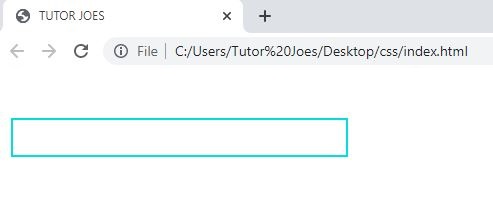
Attribute selectors provide a powerful way to target specific elements based on their attributes and attribute values. They can be useful in cases where you want to apply styles selectively or modify the appearance of elements based on their attributes.
Grouping Selector
In CSS, a grouping selector is a way to select multiple elements and apply the same styles to all of them with a single CSS rule. It allows you to combine multiple selectors into a comma-separated list to create a group of elements that share the same styles.
The syntax for a grouping selector is as follows:
selector1, selector2, selector3 { /* Styles applied to all elements matched by selector1, selector2, and selector3 */ }
Example
h1,h2,h3,h4,h5,h6,b{ color:red; font-family:rockwell; }
Output

Grouping selectors are particularly useful when you want to apply the same styles to different elements that share a similar purpose or design. Instead of writing separate CSS rules for each selector, you can combine them into a single rule using the grouping selector.
It's important to note that while grouping selectors allow you to apply the same styles to multiple elements, they do not imply any structural relationship or hierarchy between the selected elements. The selectors within a grouping selector are treated independently, and the styles will be applied to each matched element individually.
Using grouping selectors can help you write more concise and efficient CSS code by reducing repetition and consolidating styles for related elements.
Understanding CSS selectors is essential for creating effective and efficient stylesheets. By using selectors correctly, developers can target specific elements on a web page and apply the appropriate styles, creating a consistent visual style and layout across the entire site. It's important to note that CSS selectors also have a specificity value, which determines which styles take precedence when there are conflicting styles applied to the same element. This adds an extra layer of complexity to CSS selectors, but it also allows for more fine-tuned control over the styling of a web page.
CSS Tutorial
Properties Reference
Cascading Style Sheet
Flexbox Tutorial
CSS Grid Tutorial
Transitions Properties
CSS Properties with Examples
CSS Selectors
CSS Pseudo Elements
CSS Attribute Selectors
Input Pseudo Classes
CSS Examples
CSS Animation Projects
Learn All in Tamil © Designed & Developed By Tutor Joes | Privacy Policy | Terms & Conditions